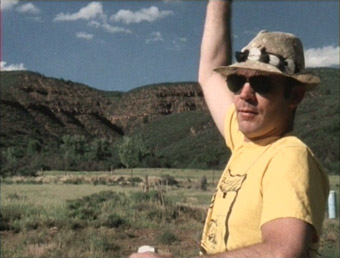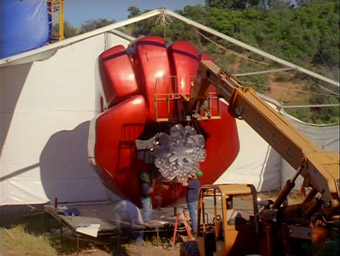When you die,
You stop drinking beer.
When you die,
You stop being here.
When you die some people cry.
When you die we say goodbye.
Yeah. |
When
You Die – Barnes and Barnes |
Planned
your funeral yet? No? Almost no-one I know has even given
it thought. Sure, they might prefer cremation over burial,
but they leave things like the style and content of their
service to surviving relatives, if they have any. There
are those who are very specific about the manner in which
their passing should be marked and their remains handled.
I distinctly remember many years ago reading about a staunch London socialist
who regarded funeral directors as vultures, and thus specified
that he should be buried in his own back garden in a coffin
made of chipboard, a request carried out by his dutiful
son. Not all suggestions are so seriously minded. Luis Buñuel
once quipped to friends (on camera) that after he died he
wanted his body hung up in the street so that passers-by
could spit on him. Most of us unconsciously avoid the whole
issue of what happens after our death as it entails directly
confronting our mortality, acknowledging on some level that
one day, as the above ditty points out, you stop being here.

Not
so Gonzo writer Hunter S. Thompson, whose plans for his
own memorial service were elaborate to the point of implausibility,
a last gag on a world that he appeared to enjoy being a
creative thorn in the side of. That those who knew and loved
him were determined to carry out his last request, no matter
how impossible the task may seem, is surely a testament
to his impact not just on friends and family but the community
in which he lived.
Now
before I go any further it might be worth outlining just
what this funeral plan consisted of. The centrepiece of
the service was to be a monument, a 150 foot high steel
arm whose base would be surrounded by a mound of large boulders,
its top bearing the two-thumbed fist that had become the
emblem of Gonzo, cast in steel and weighing over two tons.
The service itself would involve a firework display, the
climax of which would see Thompson's ashes blasted a thousand
feet up into the air in explosive canisters. The very considerable
bill for all this was footed by actor Johnny Depp, a close
friend of the writer and who played him in Terry Gilliam's film
version of Fear and Loathing in Las Vegas
(and is set to star in Bruce Robinson's upcoming film adaptation
of Thompson's The Rum Diary).
Behind
the camera recording the preparations for the event was
documentary filmmaker Wayne Ewing, whose twenty-year collaboration
with Thompson resulted in the excellent Breakfast
with Hunter and the fascinating and troubling
Free Lisl: Fear and
Loathing in Denver. It's this long-standing
friendship with Hunter and his family that allowed Ewing
to get so close to a process from which other media personnel
were excluded, to cover every aspect of the monument's construction,
from the design to the casting of the fist and installation
of a LED-lit flower to the building of the giant arm. There's
only one thing missing, a rather important thing in some
ways, but I'll get to that later.
The
construction of the monument required an alliance of the
artistic, the practical and the social, a grand design that
could face local opposition and prove an engineering challenge,
a 150-foot high steel column that would need sturdy guy-ropes to keep it standing and be erected in a field
in which lightning was known to strike (illustrated in a
very nice shot in which both the tower and earthed lightning
are captured in the same frame). In
truth, this dramatic potential soon evaporates due to a combination
of professionalism and good luck. Local permission is readily
granted, the construction of the monument proves no problem
for some first class engineering firms, and the nearest
its assembly comes to difficulty is when the covering canvas
develops a small tear and has to be sewn up. The firework
display is a different matter, the dry weather triggering
a fire ban that forbids even outdoor cigarette smoking,
and the height of the intended display becomes an issue
when the organisers are told that it might potentially conflict
with the flight paths of aircraft approaching and leaving
the local airport.

But
for the most part it's a smooth ride, good news for the
event but stripping the narrative of substantial portion
of its potential drama. Given that the film is a record
of the construction of a memorial this is not really an
issue – it would be a little churlish to complain that the
planning of a funeral service didn't play to the camera
by developing a few problems. What does give the film a
bit of a kick in the shins is it's lack of a climax. Although
the exclusion of cameras is understandable from what, in
spite of its scale, is a private ceremony, all of this extensive
groundwork can't help but build anticipation for a collective
reaction and appreciation that we never get to see. The
fireworks are there, but the faces required to deliver the
emotional punch the event deserves – and no doubt had –
are off in the darkened distance at a party to which we
have not been invited, something that tends to hurt a little
after having been so close to its preparation.
If
you can live with this then When I Die is still a consistently interesting if teasingly incomplete
record of a great writer and individualist's last shout
in a world that too often embraces the mundane and the populist
over the edgily original. If it seems more easy-going
than Ewing's other Hunter Thompson films then that's evidence
of the hole that's been left by Thompson's passing. It still
has its priceless moments, as when a truck driver delivering
part of the monument asks about a man he knows of only through
rumour. ""Who is this writer?" he asks. "Somebody
told me he's into drugs and guns, and could write. Is that
it?" Installation supervisor Dave Baker laughs and
says simply, "My kind of guy."
Framed
4:3 and shot on medium to high-band video – I'm guessing
DV-CAM but I may be wrong – the transfer is up the the usual
standards of Ewing's own DVD releases, with sharpness, colour
and contrast all as good as you could hope for. Obviously
the video format is NTSC, but there's no regional coding
to worry about.
The
Dolby 2.0 stereo soundtrack is always clear, the voice recording
first rate (not always a vérité strong point)
and the typically fine music score very nicely reproduced
– it's here that the stereo really kicks in.
None.
An
engaging record of an 'only in America' event in which the
sheer scale and audacity of the memorial seem wholly appropriate
to the larger-than-life character it is built to commemorate.
The film has definite stand-alone appeal, but is obviously
going to be of greatest interest to fans of the author,
particularly those who've already enjoyed Ewing's other
Hunter Thompson films. Despite being released before Free
Lisl, When I Die represents the
closing chapter in a too-short series – it's just a shame
that circumstances have left this well assembled and appropriately
respectful film without its grand finale.
|